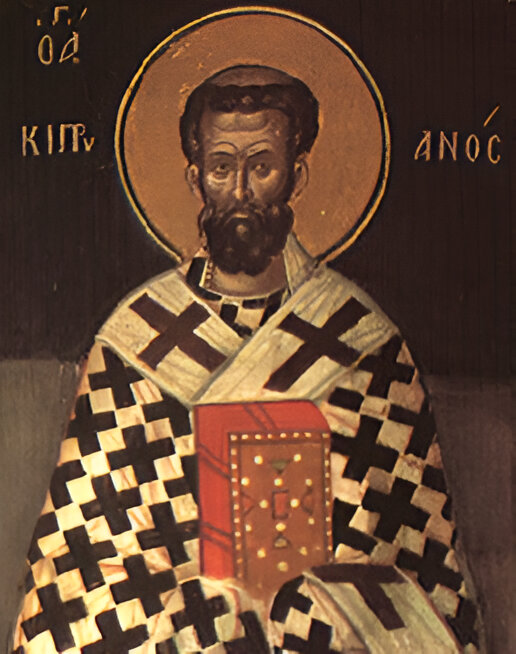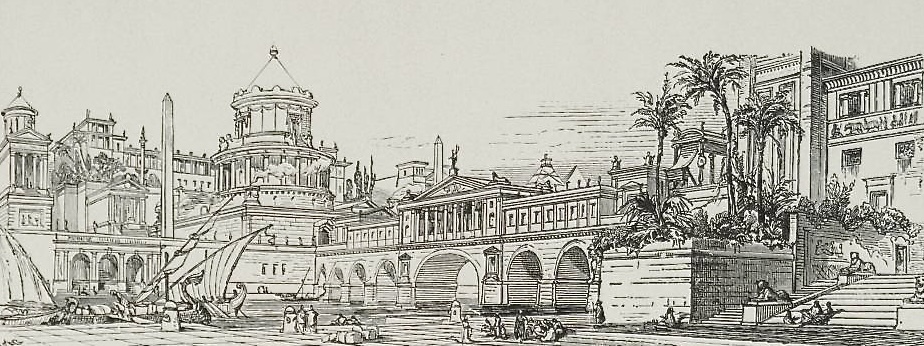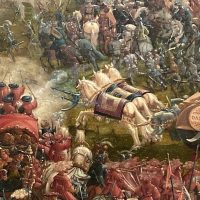Ever wondered how a disease could change an entire empire? The Plague of Cyprian was a huge event for the Roman Empire from 249 to 262 AD. In this article, we will look at the plague from two different viewpoints: one showing it as a natural disaster that made the empire’s problems worse, and another seeing it as a crisis that leaders failed to manage well. Which side do you think had the biggest impact? Read on to find out!
Perspective A: Natural Disaster Exacerbating Decline
The first perspective posits the Plague of Cyprian as a natural disaster that exacerbated the decline of the Roman Empire. The empire, already grappling with external invasions, economic downturns, and political instability, found itself ill-equipped to handle the onslaught of a pandemic. The plague, with its high mortality rate, decimated entire communities, leading to labor shortages and a collapse in trade networks.
The empire’s decline was evident in various facets, from the debasement of its currency to the frequent change of emperors. The plague, in this context, acted as a catalyst, hastening an already inevitable decline.
However, challenges to this perspective arise when considering other empires and civilizations that rebounded from similar crises. The argument could be made that the Roman Empire, with its vast resources and territories, should have been resilient enough to weather the storm.

Perspective B: Manageable Crisis Mishandled by Leadership
The second perspective paints a different picture. It suggests that while the Plague of Cyprian was undoubtedly severe, it was a manageable crisis that was mishandled by the leadership of the time. This viewpoint underscores the empire’s failure to implement effective quarantine measures, provide medical assistance, and maintain public order.
The strength of this perspective lies in its focus on human agency. It suggests that with better leadership and governance, the empire could have mitigated the worst effects of the plague. This viewpoint also aligns with accounts of local leaders, like Cyprian himself, who stepped up in the absence of imperial leadership, offering aid and solace to the afflicted.
However, critics might argue that the scale and nature of the plague were beyond any contemporary understanding or management. Expecting the leadership of the time to have the foresight and knowledge we possess today could be deemed anachronistic.
In Conclusion
The Plague of Cyprian stands as a testament to the fragility and resilience of human societies. Whether viewed as a natural disaster that expedited the decline of a great empire or as a crisis exacerbated by leadership failures, its impact is undeniable. As we reflect on this historical event, it serves as a poignant reminder of the interplay between nature, leadership, and the course of history. Readers, equipped with these perspectives, can now appreciate the multifaceted nature of the Plague of Cyprian and its lasting legacy.
Which perspective on the Plague of Cyprian do you agree with: natural cause or bad leadership? 🏛️💬
Comment at the end of this Article 😉
The Plague of Cyprian: The Silent Scourge of the Roman Empire
In the heart of the Roman Empire, a silent enemy emerged, leaving behind a trail of devastation and altering the course of history. This enemy was not a foreign invader or a political adversary but a mysterious disease known as the Plague of Cyprian. Named after Saint Cyprian, the bishop of Carthage who meticulously documented its horrors, this plague’s impact on the empire was profound and far-reaching.
City in Despair
Carthage, a bustling metropolis of the Roman Empire, was one of the first cities to feel the plague’s wrath. As described by Saint Cyprian, the disease began with mild symptoms: fatigue, gastrointestinal distress, and fever.
However, as days turned into weeks, the afflicted would develop severe diarrhea, vomiting, and gangrenous hands and feet.
The streets, once filled with the sounds of commerce and laughter, echoed with the cries of the sick and the mourning.
Empire’s Response
The Roman leadership, already grappling with external threats and internal strife, found itself overwhelmed. The medical knowledge of the time was rudimentary, and the origins and nature of the plague remained enigmatic. Temples that were once centers of worship and community became makeshift infirmaries, and priests, including Cyprian himself, became caregivers.
Societal Impact
The Plague of Cyprian was not just a health crisis; it was a socio-economic catastrophe. With a significant portion of the population either sick or in mourning, labor shortages became rampant. Fields lay fallow, trade routes were disrupted, and the once-mighty Roman economy began to falter. The plague also ignited religious debates, with pagans blaming Christians for angering the gods, while Christians viewed the plague as a test of faith.
The Plague of Cyprian: Alexandria’s Descent into Chaos
Amidst the grandeur of the Roman Empire, a shadow crept into the bustling port city of Alexandria in Egypt. This shadow was neither a conquering army nor a political coup but a silent, deadly plague that would come to be known as the Plague of Cyprian. Through the annals of history, the tales of its devastation echo, particularly in the vibrant heart of Alexandria.
Alexandria’s Golden Era
Before the plague’s arrival, Alexandria was a jewel of the Mediterranean. Renowned for its Great Library and the Pharos Lighthouse, one of the Seven Wonders of the Ancient World, the city was a hub of trade, culture, and learning. Scholars, merchants, and tourists flocked to its shores, making it a melting pot of ideas and innovations.

Darkness
However, in the mid-3rd century AD, a mysterious illness began to grip the city’s inhabitants. Symptoms ranged from fevers and dysentery to the horrifying necrosis of the extremities. The once-bustling marketplaces grew silent, scholars abandoned their scrolls, and the city’s vibrancy dimmed.
Historical records, including those penned by Saint Cyprian, the bishop of Carthage, describe the plague’s horrors. But it was in Alexandria where the combination of dense population and frequent interactions made the disease particularly catastrophic.
Empire’s Struggle
The Roman administration in Alexandria tried to maintain order, but the scale of the crisis was overwhelming. Food supplies dwindled as farmers succumbed to the disease or avoided the city. The famed Great Library saw a decline in scholars, and religious tensions flared as people sought answers and solace.
Aftermath
While the Plague of Cyprian eventually receded, its impact on Alexandria was lasting. The city’s decline in trade and scholarship took decades to recover. The plague served as a stark reminder of nature’s power to alter the course of history, even in the mightiest of empires.
More of → Perspectives ←
FAQ
1. How did the Plague of Cyprian influence religious beliefs and practices of the time?
The Plague of Cyprian had a profound influence on religious beliefs and practices. As the disease ravaged communities, many pagans turned to Christianity, seeing the selfless care provided by Christian communities to the sick. Saint Cyprian, from whom the plague gets its name, viewed the epidemic as a test of faith, urging believers to aid those affected. The plague, in many ways, acted as a catalyst for the spread of Christianity within the Roman Empire.
2. Were there any notable medical advancements or practices that emerged as a result of the Plague of Cyprian?
While the medical understanding of the time was limited, the Plague of Cyprian did push physicians and scholars to seek remedies and better care methods. Galen, a prominent physician of the era, wrote extensively about the symptoms, likening them to the Athenian plague. Though no definitive cure was found, the crisis highlighted the need for organized medical care and paved the way for future advancements in public health.
3. How did the Plague of Cyprian compare to other historical plagues in terms of its impact and spread?
The Plague of Cyprian, while devastating, was one of several plagues that impacted ancient civilizations. Compared to events like the Justinian Plague or the Black Death, its death toll was lower. However, its socio-political impact, especially on the Roman Empire’s stability, was significant. The plague’s spread was facilitated by trade routes and dense urban populations, similar to other historical plagues.
4. What economic repercussions did the Roman Empire face due to the Plague of Cyprian?
The Plague of Cyprian severely disrupted the Roman economy. With a significant portion of the workforce either dead or incapacitated, agricultural output dwindled. Trade routes were disrupted, leading to shortages and inflation. The economic strain further exacerbated the political challenges the empire was facing, hastening its decline.
5. Did the Plague of Cyprian have any long-term cultural or artistic impacts on the Roman Empire or neighboring civilizations?
The trauma of the Plague of Cyprian was reflected in the art, literature, and philosophical discourses of the time. Writings from the period often allude to the fragility of life and the unpredictability of fate. The plague also influenced religious art, with depictions of suffering and divine intervention becoming more prevalent. Neighboring civilizations, through trade and communication, would have been exposed to these cultural shifts, leading to a shared sense of vulnerability and introspection.
Which perspective on the Plague of Cyprian do you agree with: natural cause or bad leadership? 🏛️💬
This was a delight to read. You show an impressive grasp on this subject! I specialize about Appliances and you…
i think he was just a crazy guy, a victim of his childhood and enviroment
super interesting 🤔
Loved this article, learned a lot!




Leave a Reply